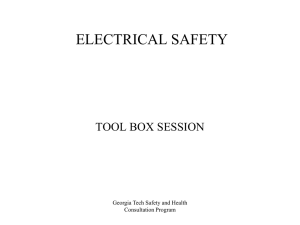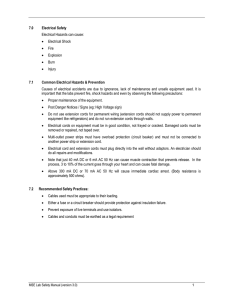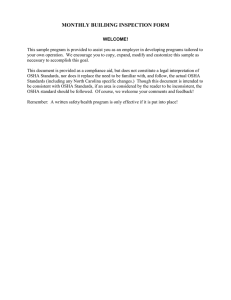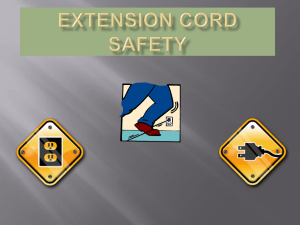Tool Box Talk: Electrical Safety
advertisement
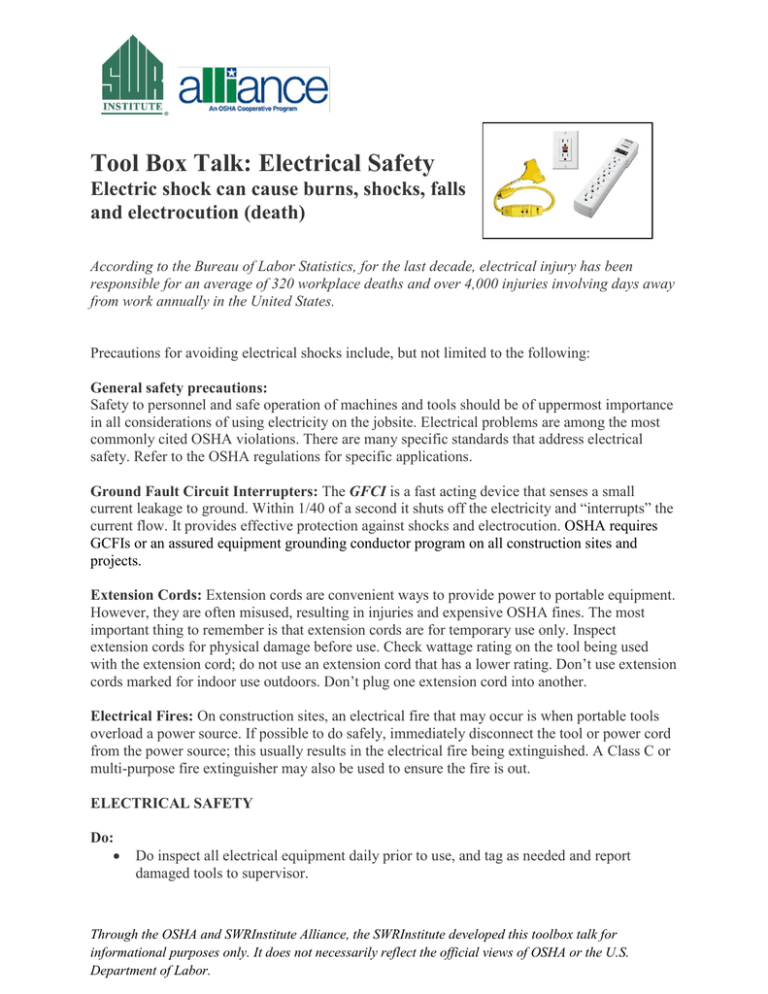
Tool Box Talk: Electrical Safety Electric shock can cause burns, shocks, falls and electrocution (death) According to the Bureau of Labor Statistics, for the last decade, electrical injury has been responsible for an average of 320 workplace deaths and over 4,000 injuries involving days away from work annually in the United States. Precautions for avoiding electrical shocks include, but not limited to the following: General safety precautions: Safety to personnel and safe operation of machines and tools should be of uppermost importance in all considerations of using electricity on the jobsite. Electrical problems are among the most commonly cited OSHA violations. There are many specific standards that address electrical safety. Refer to the OSHA regulations for specific applications. Ground Fault Circuit Interrupters: The GFCI is a fast acting device that senses a small current leakage to ground. Within 1/40 of a second it shuts off the electricity and “interrupts” the current flow. It provides effective protection against shocks and electrocution. OSHA requires GCFIs or an assured equipment grounding conductor program on all construction sites and projects. Extension Cords: Extension cords are convenient ways to provide power to portable equipment. However, they are often misused, resulting in injuries and expensive OSHA fines. The most important thing to remember is that extension cords are for temporary use only. Inspect extension cords for physical damage before use. Check wattage rating on the tool being used with the extension cord; do not use an extension cord that has a lower rating. Don’t use extension cords marked for indoor use outdoors. Don’t plug one extension cord into another. Electrical Fires: On construction sites, an electrical fire that may occur is when portable tools overload a power source. If possible to do safely, immediately disconnect the tool or power cord from the power source; this usually results in the electrical fire being extinguished. A Class C or multi-purpose fire extinguisher may also be used to ensure the fire is out. ELECTRICAL SAFETY Do: Do inspect all electrical equipment daily prior to use, and tag as needed and report damaged tools to supervisor. Through the OSHA and SWRInstitute Alliance, the SWRInstitute developed this toolbox talk for informational purposes only. It does not necessarily reflect the official views of OSHA or the U.S. Department of Labor. Do survey the work site for overhead power lines and other electrical hazards when using ladders or working platforms. Maintain the required distance from electrical equipment and conductors. This distance depends on the voltage hazard. Do provide adequate overload and short-circuit protection for safe operation. The interrupting capacity of all breakers and fuses must be sufficient to clear the fault current rapidly and without damage to itself. Do provide cord protection for flexible cords and cables passing through doorways or other pinch points. Do keep a fire extinguisher on work site at ALL times. The standard procedure for fighting electrical fires is to open the circuit and then apply an approved extinguishing agent. A carbon dioxide (CO2) extinguisher offers the advantage of extinguishing the fire, cooling the apparatus, leaving no residue, and having no adverse affect on the insulation and metal parts; it may be used on live circuits. CO2 should not be used in confined spaces, unless a breathing apparatus is used. A dry chemical extinguisher may be used; however it will leave a residue. Do avoid mixing water and electricity. Keep electrical equipment, hands and feet, and working surface dry. Do check all electrical equipment and notify others that are also connected to the power source before resetting GFCI or breakers. Do use a GFCI on all construction sites. Do Not: Do not use Shop Made Cords with Receptacle Boxes. Among the most common electrical violations is when a multiple receptacle box, designed to be surface mounted, is fitted with a flexible cord and is placed on the floor to provide power to various tools or equipment. These are not permitted and should be taken out of service. Do not use a length or size (wire gauge) extension cord that exceeds the max recommended by tool manufacturer. Do not splice extension cords with electrical tape. Splices should be approved permanent splices. Hard service flexible cords 12 AWG or larger may be repaired if spliced so that the splice retains the insulation, outer sheath properties, and usage characteristics of the cord being spliced. Do not leave extension cords in walk ways or work areas causing a trip hazard. Do not use worn frayed or damaged cords Do not fasten extension cords with staples, hang from nails, or suspend from wire. Do not exit your vehicle if it comes in contact with electricity. Drive away until the electricity is no longer in contact with you vehicle. If the engine stops running, call 911 for assistance. Through the OSHA and SWRInstitute Alliance, the SWRInstitute developed this toolbox talk for informational purposes only. It does not necessarily reflect the official views of OSHA or the U.S. Department of Labor. Review Questions: 1) A GFCI senses electrical leakage? A) True B) False 2) A Fire extinguisher should not be onsite all times in case of electrical or other types of fire? A) True B) False 3) Worn extension cords should be removed from service? A) True B) False 4) The human body has a low resistance to electricity; this makes it a good conductor? A) True B) False Talk Given By: ___________________________ Date: ______________________ Company: _______________________________ Location: ___________________ Printed Name Signature Through the OSHA and SWRInstitute Alliance, the SWRInstitute developed this toolbox talk for informational purposes only. It does not necessarily reflect the official views of OSHA or the U.S. Department of Labor.
